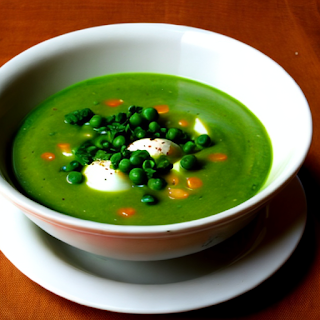The origins of Spinach & Pea Soup can be traced back to traditional European cuisines, where both spinach and peas have been cultivated for centuries. Spinach, native to Persia (modern-day Iran), spread to Europe in the Middle Ages and became a popular leafy green vegetable in Mediterranean and Northern European cuisines. Peas, on the other hand, have been a dietary staple in Europe since ancient times, valued for their versatility and nutritional benefits.
Over time, various regions developed their own versions of pea soups, often incorporating local ingredients and culinary techniques. Spinach & Pea Soup emerged as a flavorful and nutritious variation, combining the vibrant green color and earthy flavor of spinach with the sweetness of fresh peas.
As culinary traditions evolved, Spinach & Pea Soup became a beloved dish in households across Europe and eventually gained popularity in other parts of the world. Its simplicity, versatility, and healthful ingredients have made it a timeless favorite, enjoyed by people of all ages and dietary preferences.
In modern times, Spinach & Pea Soup continues to be celebrated for its delicious taste and nutritional value, with chefs and home cooks alike experimenting with different variations and additions to suit their preferences.
Ingredients
2 Tbsp olive oil (or another plant-based oil)
1 cup scallions white and green parts, chopped
1/2 cup onion, or 1 small onions, chopped
1 cup carrots, chopped
1/4 cup celery, chopped
2 Tbsp basil, chopped
Salt to taste
1/2 cup water
1/4 tsp pepper
1/3 cup parsley, chopped (stems and all)
4 cups spinach, stems removed
1 cup peas, fresh or frozen
Lemon juice to taste (about 1 tsp—1 Tbsp)
Garnish with plain Greek yogurt (low fat preferable)
Directions
1. In a soup pot, heat the oil until it ripples a bit.
2. Add the scallion, onion, carrot, celery, herbs, salt and sauté lightly for 3-5 minutes.
3. Add 1/2 cup water, cover and stew for 4 minutes.
4. Add 5 cups water and bring to a boil.
5. Lower heat and simmer, uncovered for about 20 minutes.
6. Add pepper, parsley, spinach, peas, and cook 3 minutes until they turn bright green.
7. Remove from heat and blend the soup until smooth.
8. Add lemon juice as needed, and salt and pepper as needed.
9. Serve garnished with plain Greek yogurt.


Comments
Post a Comment
Thanks for your feedback